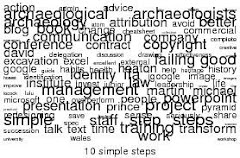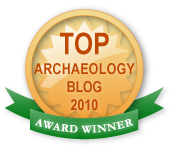In times like these, effective marketing can make all the difference between survival and closure. Does your current strategy deliver business? Or are you wasting time and money?
If you're relying on repeat business from your existing developers, you will starve
There were 4,500 developer-funded reports per year sent to HERs in England before the credit crunch (source: Archaeological Investigations Project)
There were 500,000 planning applications per year (source: Planning Portal)
So, on average, 1 in 100 planning applications leads to archaeological work of some sort. So even if a developer is highly active and submits a lot of applications, they are unlikely to need archaeological assistance more than once in a blue moon.*
If you're relying on word-of-mouth you will starve
Developers don't talk to each other very much, and certainly don't share their commercial secrets. They won't recommend you to their competitors. And in any case, given the low incidence of archaeology, it won't be often that someone who has had a problem meets someone who has got one at the moment.
If you're relying on your reputation you will starve
You can't rest on your laurels and wait for work to turn up based on your reputation. The only archaeologists likely to be recognised outside the archaeological community are Time Team (and maybe Bonekickers).
Every project is a first date
You need to make a good first impression. It's no good muddling along and then producing the best report in the world at the end: they won't hang around. But managing that impression is difficult.
What will be noticed
Price
Answering emails and phone calls quickly and politely
Having professional-looking stationery, staff and premises
Professional and quality accreditation
Friendliness, enthusiasm and efficiency
What curators say about you
What won't be noticed
Academic credibility
Specialist knowledge
Previous experience
What past customers say about you
I man ways, this is depressing, since it means that the qulaities we value highest are least effective. But it's probably better to realise that, I think.
* Environmental Assessments are different: developers for types of development that require these *will* be repeat customers and *will* know about archaeology.
Friday 27 February 2009
The archaeological marketplace
Posted by
Martin Locock
at
20:00
0
comments
![]()
Labels: communication, crunch
Wednesday 11 February 2009
Training without a training budget
It may seem a bad time for the IfA to be promoting CPD, when for once there really is a rational case for reducing expenditure on training. But much of the entrenched (ho ho) opposition to compulsory CPD schemes over the years has been the result of a misconception that CPD must mean training and training must mean formal expensive courses. For some topics that may be the case, but there is a great deal of value to the individuals and the organisation that can be done at little or no cost.
Sharing expertise
Do all your field staff recognise finds? If not, it would be well worthwile spending an afternoon looking at local pottery types, clay pipe, animal bone, glass. Many recent graduates may have had little opportunity to handle material and learn the diagnostic features.
Make sure everybody in the organisation takes decent photos: this may involve looking at the various cameras you use and what the options mean. Perhaps more importantly, it is a chance to discuss why we take photos and what use they are. It is depressing to think quite how many hours have been spent over the last two decades taking multiple poor photographs of uninteresting features which have each been carefully catalgued and archived.
Most organisations have people working in silos: they may have adjoining offices but have no idea at all what other people do or why. Get them to explain their role. Quite apart from anything else, it's good practice in giving presentations.
Talk about project costings. These shouldn't be mysterious: an understanding of how they are done, and what they eman, may well have an immediate pay-off in attitudes and behaviour, once they realise quite how much money goes on plant hire.
Also, it's easy for organisations to forget that new staff don't know the history: it would be useful for them to know a little about why it was set up, what its major projects have been.
And one thing you can't do enough of is discussing grammar and layout and the real nitty-gritty of report writing.
Goal-orientated learning
Arcaheologists have a long and honourable tradition of teaching themselves new stuff when they need to. This is particularly true of software. Over the last year I have picked up some html, xml, wiki formatting, Powerpoint design, and print-on-demand publishing, because, in each case, I needed or wanted to achive something and so had to work out how to do it. It's true that this reactive type of learning is hard to fit within the CPD framework, although it is possible to some extent to predict areas you might want to develop.
Updating knowledge
Unlike a lot of things for which training is expensive, gathering archaeological information, on developments in Mesolithic studies or Roman urban sites, is free or cheap. Read some books and journals; go to a talk or two. These are real and worthwhile learning activities and, who knows, may even make you better at your job.
With a little imiagination, it's possible to carry out a transfomative training porgramme across an organisation without ever having to write a hundred-pound cheque to an 'expert'.
Posted by
Martin Locock
at
19:08
0
comments
![]()
Sunday 8 February 2009
Hard time economics
Any doubt about the impact of the recession on commercial archaeology has been removed by the recent IFA/FAME report on Job Losses in Archaeology. Depressingly, this news has already led to the re-emergence of rhetoric about cowboy contractors and dodgy freelances. It is sad that archaeologists instinctively think that any organisation that operates more cheaply than them must be transgressing established standards of practice, when these are probably the least threatened area.
It is worth thinking, though, about what a mature commercial archaeology industry would look like. The starting point must surely be that a unit should conduct its main operations within, say, one hour travelling time from its base. It can make no sense in the long term for field teams to commute or live in accommodation: either that becomes very expensive (if those involved are properly compensated), or very demoralising (if they aren't). The logic of 'super units' like Wessex and Oxford is debatable. From the starting point of a unit covering a radius of 30-50 miles, you can work out how much archaeological work can be expected, and therefore how many staff are needed. If the current capacity is more than the work available, the unit is unsustainable even in times of high economic activity.
One question that seems mystifying to many diggers is how one-man-bands (OMBs) and freelances can undercut established units. Maybe they do turn up on site in sparkling new 4x4s and use gold-plated trowels, or maybe they don't.
What the successful ones do is:
* work hard - not 8 hours a day, 10 or 12 (office work gets done in the evenings)
* limit overheads - minimal office staff
* cost carefully
* work locally
* know their area well
* don't pay themselves much
There will always be a market for OMBs alongside larger units. OMBs offer personal service and cheapness: to compete, units need to offer something more, in terms of reliability, range of skills, track record, professionalism and scale. Some clients will go for the certainty of outcome of an established unit; others will take a risk. Perhaps the hardest thing for OMBs to handle is contingencies: if a minor watching brief suddenly turns into a Roman cemetery excavation, where can they find a digging and specialist team to deploy in a hurry? Having said that, units might have problems responding too, but since they have more than one project at once there is at least the possibility of switching resources when needed.
The real problem for unit faced with a drop in workload is cutting back. The idea that less digging means fewer diggers is one that most managers can grasp. But unless overhead costs are reduced, they will become ever more disproportionate as the volume of work drops.
How to cut overheads
There are no painless cuts. Archaeologists expect admin support, facilities, and management. Hard luck: they may be luxuries.
As turnover drops, the ability to resource secretarial and administrative support shrinks. Because archaeologists don't pay themselves very much, it is often cheaper to get them to do this work. There was a time when the hassle of sending faxes, typing letters and routing phone calls was a distraction for archaeological staff, and it therefore made sense to employ office staff to handle them, but perhaps these days with email and mobile phones that is no longer true. Most units are stuck in an 80s organisational model of who does what.
One of the problems with project work is that the team involved pays little attention to the wider organisation: it's 'just there'. 'Why aren't there any more context sheets?', people ask, not expecting the answer 'Because you didn't get any more printed.' Tools, PPE, cameras, surveying equipment, vehicles, finds bags, computers: it's all stuff that someone has to resource. It may well be that the stock of material cannot be maintained, and projects may end up having to cost for new purchases instead. This may be wasteful and expensive, but it does have the benefit of forcing managers to consider the full historic cost of their work ratehr than the incremental costs.
Cutting management costs is hard, partly because this is managers deciding to put themselves out of a job. But it is worth thinking from scratch: how large does an organisation have to be until it can support a chief executive who undertakes no chargeable work? It depends how much they get paid, of course. But most unit are top-heavy with not one but several senior managers. This may have been sustainable in the days of large project volume, but if the volume goes down, it isn't any more. Not that they need to be sacked, but they do need to change their work pattern so that they carry out their management tasks in gaps between chargeable work.
Finally, it must be faced that many of the things that units like to do may not be possible: outreach events, open days, conferences may have to be dropped unless they come attached to their own income streams.
It is interesting to note that these measures would make units much more similar to the OMBs.
Update
A longer article based on this post was published in The Archaeologist 71 (2009) now available as a pdf
Buy 10 simple steps: the book
Transform your business with a 10 simple steps workshop.
Posted by
Martin Locock
at
10:52
0
comments
![]()






